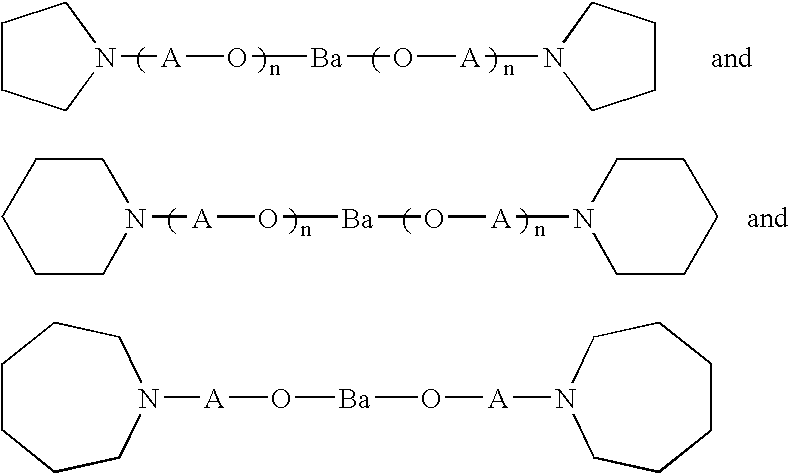Catalyst System for Synthesizing Amine Functionalized Rubbery Polymers
a functionalized rubber and catalyst technology, applied in the direction of catalyst activation/preparation, physical/chemical process catalysts, chemical/physical processes, etc., can solve the problems of difficult to formulate useful functionalized rubber compounds, difficult to improve the wear characteristics of tires without sacrificing wet skid resistance and traction characteristics, etc., to achieve high trans or high vinyl microstructure content and improve wear and tear characteristics
- Summary
- Abstract
- Description
- Claims
- Application Information
AI Technical Summary
Benefits of technology
Problems solved by technology
Method used
Image
Examples
example 1
[0061]In this experiment, 2000 g of a hexane premix containing about 20% monomer(s) consisting of 20% styrene and 80% butadiene was charged to a one gallon stainless steel reactor with an air-driven motor, a nitrogen inlet for providing an inert nitrogen atmosphere, and internal heating / cooling coils for temperature regulation. The catalyst system, which included N,N diethylaminophenyllithium and N,N, N′,N′-tetramethyl-ethylenediamine (TMEDA) was added to the premix in a ratio of 0.40 mmol of catalyst per 100 g of the monomer mixture. The molar ratio of N,N-diethylaminophenyllithium to TMEDA was 1:2.
[0062]The polymerization was carried out at 65° C. and the reaction monitored using gas chromatography (“GC”) to detect for the presence of unreacted monomers. After polymerization was completed, ethanol was added to shortstop the polymerization. The polymer cement was then removed from the reactor and stabilized with antioxidant. After evaporating hexanes, the resulting polymer was drie...
example 2
[0064]The procedure described in Example 1 was utilized in this example except that 3 mL of 0.1 M solution of barium salt of di(ethylene glycol) ethylether (BaDEGEE) in ethylbenzene and a 3 mL of a 0.1 M solution of tri-n-octylaluminum (TOA) in hexanes, instead of TMEDA, was added to N,N diethylaminophenyllithium making a molar ratio (BaDEGEE / TOA / diethylaminophenyllithium) of 1:4:3. The resulting styrene-butadiene polymer was determined to have a Tg at −72° C. The microstructure content was determined to include a trans 1,4 polybutadiene content of about 79%, cis 1,4 polybutadiene content of about 17%, a 1,2 polybutadiene content of about 4%, and a polystyrene content of about 15%.
example 3
[0065]The procedure described in Example 1 was utilized in this example except that the premix containing about 20% monomer(s) included 30% styrene and 70% butadiene. The resulting styrene-butadiene polymer was determined to have a Tg at −33° C. The polymer had a number average molecular weight (Mn) of about 300,000 g / mol. The microstructure content was determined to include a trans 1,4 polybutadiene content of about 15%, cis 1,4 polybutadiene content of about 20%, a 1,2 polybutadiene content of about 65%, and a polystyrene content of about 30%.
PUM
| Property | Measurement | Unit |
|---|---|---|
| structure | aaaaa | aaaaa |
| wet skid resistance | aaaaa | aaaaa |
| rolling resistance | aaaaa | aaaaa |
Abstract
Description
Claims
Application Information
 Login to View More
Login to View More - R&D
- Intellectual Property
- Life Sciences
- Materials
- Tech Scout
- Unparalleled Data Quality
- Higher Quality Content
- 60% Fewer Hallucinations
Browse by: Latest US Patents, China's latest patents, Technical Efficacy Thesaurus, Application Domain, Technology Topic, Popular Technical Reports.
© 2025 PatSnap. All rights reserved.Legal|Privacy policy|Modern Slavery Act Transparency Statement|Sitemap|About US| Contact US: help@patsnap.com



